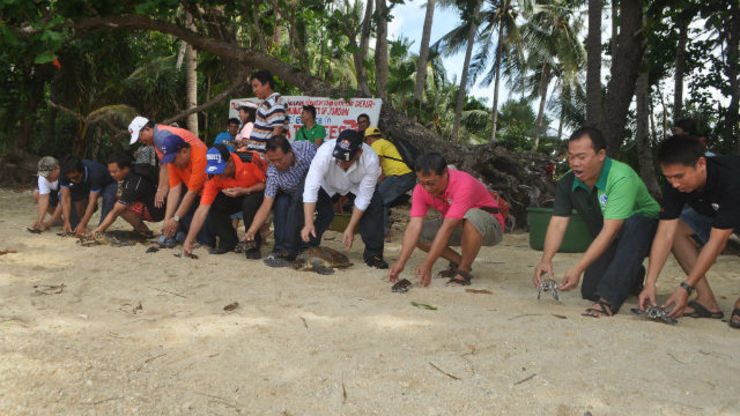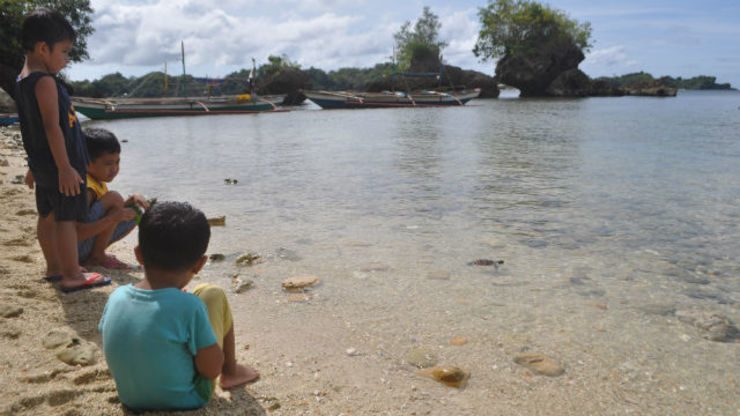SUMMARY
This is AI generated summarization, which may have errors. For context, always refer to the full article.

GUIMARAS, Philippines – Thirty-nine sea turtles, also called pawikans, were lined 5 meters away from the sea. At a signal, human fingers released their grip and flippers began inaudibly clapping as they made their way across the sand.
For the 37 hatchlings, it was the very first time they would be entering the sea kingdom. For the other two, it was a sweet homecoming.
It should not be a surprise that among all of them, it was the green sea turtle that won the race to the sea. Perhaps, it was its bigger flippers that made it very fast (in turtle standards). Or perhaps, it was its profound longing, being kept in captivity for 6 long years in a pen that was only several meters away from the sea, constantly tormented by the unending call of the waves.
Be back for ‘shore’
Around 8 months ago, the hatchlings were still inside their eggs in “turtle nests” which are really nothing more than holes in the dirty-white sands of Sitio Punta in the village of Lawi, Jordan town, Guimaras.
Nemesio Gencianeo had reached his golden years looking after these turtle nests. As his father had done before, other locals and Nemesio surrounded these nests with nets for protection and security. After about 60 days, the baby turtles pushed their heads out of the sand.
Because of some defects on the nets, several of these newly-hatched turtles prematurely, and dangerously, joined the sea. The remaining were transferred to pens where they were fed with small fishes, chopped into bits and pieces as human babies are fed with mashed food. The residents claimed they used their individual and barangay funds for these efforts.
Newly-hatched turtles have only 1% survival in the wild, said Vicente Sardina, Provincial Environmental and Natural Resources Officer, justifying the initiative of the locals.
The 37 hatchlings are hawksbill sea turtles (Eretmochelys imbricata), a species declared by the World Conservation Union as “critically endangered,” just a notch lower than “extinct.”
The egg shells locally known as alukaba were reportedly confiscated by the DENR to prevent and discourage people from seeing endangered species as a source of income.
The morning of their freedom in December 2014, these 8-month-old turtles no bigger than an average Filipino’s palm returned to the shore where they were born, at the mercy of predators of which the most terrible and also the most magnanimous is man.
To the passive onlooker, their slow struggle to traverse a few meters of sand to water must have been painful to watch. But scientists claim that this was a crucial ceremony. A hatchling has to taste and feel both sand and water, to memorize the chemical composition of its birthplace. If it is a female, it will return in time to give birth to the next generation. If it is a male, it will never set a flipper there ever again.
By this principle, the birth of these 37 hatchlings proved that turtles came to this shore many years before, way before the first resident of the village was born or any man in the world ever learned to walk on two feet.
And if God be kind and man be sensible for his own sake, these turtle hatchlings – no matter how old they get or how far out in the world they swim – will always return.
Old and gold
Two bigger turtles also gained their freedom.
The first is a green sea turtle (Chelonia mydas) that was kept by a local resident. After being one of the main “tourist attractions” during island hopping boat trips, it was finally reunited with the sea after 6 years. Its species is classified as “endangered.”
This green sea turtle’s carapace measured 17 inches in width and 18.5 inches in length. It bears an identification tag PH1197I on its right front flipper.
The other is also a hawksbill turtle rescued by the residents of Sitio Punta Lawi after being caught in a fisherman’s net. According to village chieftain Ramon Sanico, they reported the incident to the local DENR officials and they were allowed to keep it for two months so it can recover from its injuries.
This hawksbill turtle measured 17 inches in width and 18 inches in length. Its identification tag PH1198I is also on its right side flippers.
According to Municipal Environmental and Natural Resources Officer Leonidas Tan, these turtles are highly migratory. They swim across the Indo-Pacific region and across several continents, getting to countries like Japan, Korea, Russia and even the United States. The identification tags tell of these turtles’ origins and serve as a way of monitoring for the DENR’s database.
Green sea turtles notable for their teardrop-shaped carapace, feed on sea grasses. Their wastes serve as food for fishes. They contribute to the life cycle of sea grasses and circulate nutrients in the sea. Hawksbill sea turtles “clean” the coral reefs from sponges thereby attracting more fishes. They are named such because of their sharp, curved beak-like mouths.
Pledge of the humans

The floor was sand and the walls were the cliffs.
In the simple ceremony on a remote beach that looked like a small white chip in a gray stone wall, local officials of the island province of Guimaras sat together in plastic stools around a bamboo table.
As the sky, the coconut trees, and the sea turtles as witnesses, Representative Juan Carlos Rahman Nava committed to establish a turtle sanctuary. Governor Samuel Gumarin also announced the allotment of P600,000 from the provincial fund to support the project.
Furthermore, Guimaras implemented on August 2014 an Anti-Plastic Ordinance which prohibits the use of plastics all over the province. Dan Elby Habaña , provincial chairperson of the Committee on Environment, assured that it is being fully implemented but remains on the advocacy level. Resort owners may face suspension or termination of licenses to operate for non=compliance.
Turtles can get trapped inside plastic wastes and harm themselves. Some mistake floating plastics as jellyfish leading to ingestion which likely results to death.
The real ‘mutant’ and ‘teenager’
More than the harmony between mammals and reptiles, the freeing of 39 pawikans in Barangay Lawi, Guimaras was somehow a bend in the line of time – a meeting of different epochs.
Scientists believe the earliest known turtles are from 220 million years ago. The earliest proposed hominid fossils date only from 7 million years back.
Turtles co-existed with the dinosaurs, mighty protagonists of a tale that precedes both time and history. And the turtles survived what the great and the fierce dinosaurs didn’t.
Where is that green sea turtle now? Does it remember the same seascape and will it meet its old friends after 6 years of being ashore? How do the turtle hatchlings fare in the depths of the sea? Will they learn about plastics the hard way?
Perhaps one day, one of those turtle hatchlings will return to the shores of Sitio Punta Lawi and happily lay its eggs. None of those who had set it free might still walk the earth by then but their children and grandchildren would know about turtles, not only in pictures or stories, as with the dinosaurs.
And that’s how the human species will measure its success. – Rappler.com
Add a comment
How does this make you feel?
There are no comments yet. Add your comment to start the conversation.